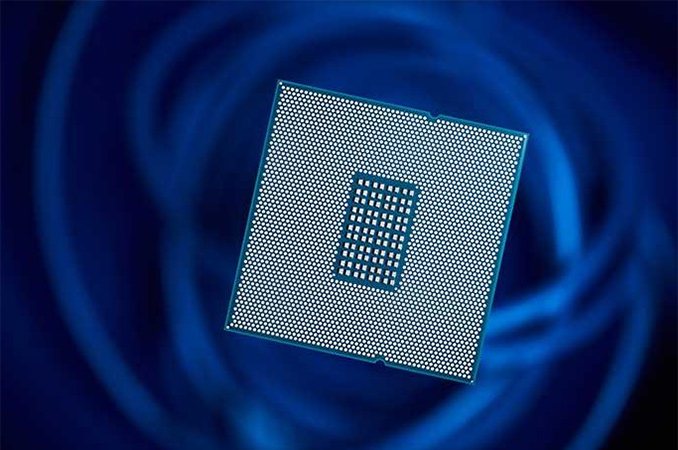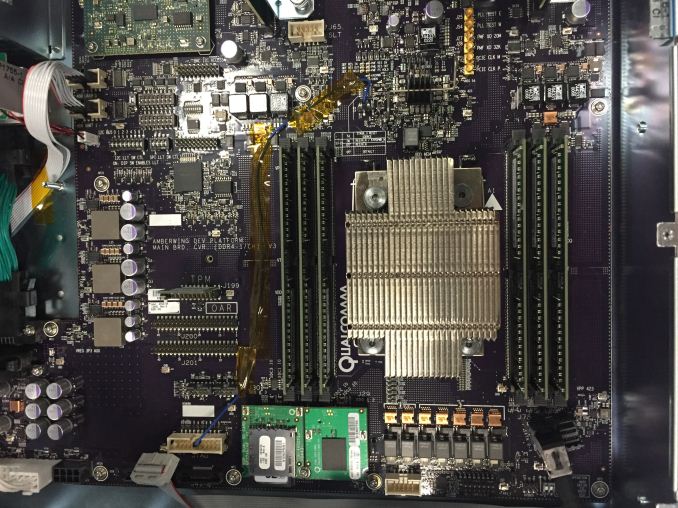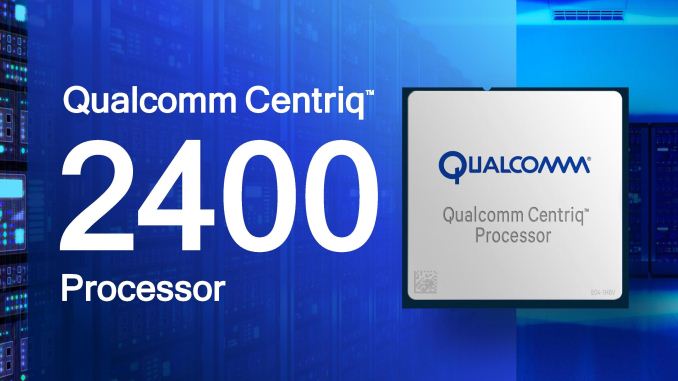Qualcomm’s Server Team Loses VP of Technology, Centriq Future Unknown
by Ian Cutress on July 6, 2018 2:00 PM EST- Posted in
- CPUs
- Qualcomm
- SoCs
- Enterprise CPUs
- Servers
- Centriq
- Centriq 2400

Normally we don’t particularly comment on these sorts of transitions at big companies unless they are C-level (CEO, CTO), however the narrative surrounding Qualcomm’s Centriq product line is still one that is perceived to be in flux. Qualcomm never commented on the rumors about its plans to find a buyer for Centriq, despite Axios and Bloomberg both reporting on them, and as a result never confirmed or denied the proposition: ultimately leading others to speculate. Followed by Anand Chandrasekher’s swift exit, again without public comment about reasons or replacement, and now another senior figure exiting the scene, brings more questions to the table than it answers.
The team behind Qualcomm Datacenter Technologies server platform, Qualcomm’s Centriq, has been in the news this past year as one of the key players in bring Arm architecture cores to the server and enterprise market. So far the time line looks like this:
- November 2014: Announced Plans to Enter Server Market
- December 2016: First 48-Core Demo and Sampling
- August 2017: Falkor Microarchitecture Detailed (Hot Chips)
- November 8th 2017: Cloudflare publishes integration testing
- November 10th 2017: Official Launch (for revenue) and Pricing
- May 8th 2018: Bloomberg Reports QDT may abandon Centriq
- May 13th 2018: Anand Chandrasekher, President of QDT, Leaves
- June 14th 2018: QDT Downsizing, 280 Jobs Cut
In 2017, Qualcomm announced the Centriq 2400 family of processors, built on Arm architecture cores at 10nm, for the enterprise and server market. This was meant to be the big break for Arm cores in the server market by a massive player that has the engineering staff and infrastructure to build a sizable customer base. The biggest version of the design implemented 48 of Qualcomm’s Falkor Arm v8 cores, paired with 60 MB of L3 cache, six channels of DDR4, running at a 2.2 GHz base frequency for 120W TDP and a price just shy of $2000: it was set to compete aggressively in the cloud server markets in performance per watt, overall performance, and cost. To date, Cloudflare has made the biggest noise about transitioning its DDoS protection platform from x86 to Centriq.

Qualcomm Centriq 'Amberwing' Development Platform, from Cloudflare
| Qualcomm Centriq 2400 Series | |||
| AnandTech.com | Centriq 2460 | Centriq 2452 | Centriq 2434 |
| Cores | 48 | 46 | 40 |
| Base Frequency | 2.2 GHz | 2.2 GHz | 2.3 GHz |
| Turbo Frequency | 2.6 GHz | 2.6 GHz | 2.5 GHz |
| L3 Cache | 60.0 MB | 57.5 MB | 50 MB |
| DDR4 | 6-Channel, DDR4-2667 | ||
| PCIe | 32 PCIe 3.0 | ||
| TDP | 120 W | 120 W | 110 W |
| Price | $1995 | $1373 | $888 |
However since the announcement, availability from the major server providers has been next to nil.
Back in May this year, almost at the same time as reports suggesting that Qualcomm was looking to offload (sell/close) the server processor division, Anand Chandrasekher left the company without much of a warning, at least publically, and aside from a personal tweet about leaving Qualcomm, no official note was given as to Anand’s replacement. The reports regarding the company offloading the server division were never confirmed, and behind the scenes several trusted sources reached out to AnandTech to say that this wasn’t really the case. Qualcomm has kept mum on the issue.
Fast forward to today, and another surprise hit our screens. One of the key members of the Falkor team, Dr. Dileep Bhandarkar, VP of Technology at Qualcomm Datacenter Technologies (QDT), seems to have parted from the company. Dileep was very much a key person for Falkor, purposefully spending time to track us down at Hot Chips after we published our detailed microarchitecture analysis and introduce us to the engineers, as well as chairing the Server Processor round of talks at the same event. The reasons for Dileep’s transition out of QDT are unknown. His departure was discovered due to his speaker biography for SemiCon West 2018 stating ‘formerly Qualcomm’.
Dr. Bhandarkar’s role is an important one here: he was a Director of Advanced Architecture at Intel for 12 years until 2007 (being a lead spokesperson for Intel’s server platform technologies), is an IEEE Life Fellow, has spent almost six years at Microsoft driving innovation and standards for its datacenters, and then a similar amount of time at Qualcomm working on technology strategy and business development, developing (among other things) machine learning accelerators currently in use at a major cloud provider. It would appear that rather than joining another industry behemoth, he is starting his own DNN based business.
So normally we don’t particularly comment on these sorts of transitions at big companies unless they are C-level (CEO, CTO), however the narrative surrounding Qualcomm’s Centriq product line is still one that is perceived to be in flux. Qualcomm never commented on the rumors about its plans for Centriq, despite Axios and Bloomberg both reporting on them, and as a result neither confirmed nor denied the proposition officially, ultimately leading others to speculate. Followed by Anand Chandrasekher’s swift exit, again without public comment about reasons or replacement, and now another senior figure exiting the scene, brings more questions to the table than it answers.
Whatever Qualcomm’s plans for Centriq have been, they seem to have stalled. It would appear that the product still does not seem to be available on the open market from the standard server manufacturers, and despite lots of talk citing the products wins over Xeon chips, nothing new has been said for quite a while. These OEMs are instead pushing Cavium’s ThunderX2 designs, which seem to have been gaining traction. Despite discussing with the Centriq team about being sampled for review in Q4 last year, that never materialized. Bloomberg also reported (via notices filed at a state level) a few weeks back that the company was cutting its datacenter unit in half, with up to 280 jobs on the line. It is possible that Dr. Bhandarkar's departure may have been one of these. The same report states that Qualcomm will continue its joint ventures in China, and rather than closing the unit will ‘persevere with a revised strategy’.
“Qualcomm remains committed to data-center opportunities and is not divesting the assets,” Amon said to Bloomberg. “We are reducing our investments in the data-center business but remain committed to our China JV and to refocusing our R&D efforts for upcoming compute opportunities.”
Source: SemiCon West













34 Comments
View All Comments
Raqia - Saturday, July 7, 2018 - link
Despite the layoffs, they're still retaining a large number of employees in that division, and presumably the 2nd gen server part (worked on by the full staff) has taped by now out so they will have a good follow up part to release soon.The latest comments from Cristiano Amon which come after both Chandrasekher and Bhandarkar’s departure indicate that they're folding the server unit into their cellphone SoC division:
"Amon told Reuters that the server chip business will be rolled into Qualcom’s Qualcomm CDMA Technologies unit, which designs and sells mobile phone chips, to gain cost efficiencies."
https://www.reuters.com/article/us-qualcomm-chips/...
This makes sense given the high projected performance of the A76: a core design suitable for a high end cellphone may do very well in an energy efficient server design so long as it has a good un-core architecture.
Notably, the company plans to pursue deployment of Centriq to cell towers as edge compute:
"The company sees a future for its server efforts as higher-powered computing is added to cellular base stations. Those crucial parts of cellular networks will get chips that allow them to offer processing power to phones over wireless links. That capability will enable virtual reality and augmented reality in smartphones and offer an experience that’s comparable to those now only provided by personal computers, Amon said."
https://www.bloomberg.com/news/articles/2018-06-14...
This makes sense as major telecoms are planning to replace more traditional hardware with whiteboxes utilizing software defined networks:
http://about.att.com/story/att_deploying_white_box...
Yojimbo - Sunday, July 8, 2018 - link
"Despite the layoffs, they're still retaining a large number of employees in that division, and presumably the 2nd gen server part (worked on by the full staff) has taped by now out so they will have a good follow up part to release soon.The latest comments from Cristiano Amon which come after both Chandrasekher and Bhandarkar’s departure indicate that they're folding the server unit into their cellphone SoC division:"
I think the conclusion we can make, then, is that they will be moving those server SOC engineers back to working on custom mobile SOCs.
"Notably, the company plans to pursue deployment of Centriq to cell towers as edge compute:"
They are having trouble competing with Cavium in a segment new to both of them but they will be successful competing against Cavium's bread and butter? We'll see.
Raqia - Sunday, July 8, 2018 - link
Their goal is to commoditize compute and wean the industry off of the x86 monopoly over several generations. So long as the industry uses x86, they will be under the yoke of Intel's restrictive licensing policies as well as their non-engineering tactics for suppressing competition. Having only AMD as an alternative is not enough to avoid these. I think the conclusion we can make is closer to what was said in the article:"Amon said the restructured server chip unit will focus on large cloud computing players. He would not name U.S. targets, but said the company is hoping to sell to Chinese internet giants such as Alibaba Group Holding Ltd, Tencent Holdings Ltd and Baidu Inc through a joint venture in China.
Large internet companies tend to write much of their own internal software and can customize it for Qualcomm’s chips. That means they will not struggle like smaller players to adapt off-the-shelf data center software that is overwhelmingly written to run on Intel’s so-called x86 chips.
'It’s very clear to us that the ARM opportunity is focused on a few players where you don’t have the software x86 barrier to entry,' Amon said."
Thunder X2 targets higher performance than the Centriq but doesn't offer any advantages to owners over having x86 chips with comparable or higher power consumption and the same need for recompilation. The main thing customers may be looking for is having some leverage over Intel when it comes to pricing in supporting an alternative ecosystem when the parts are finally viable for real use.
Centriq addresses the most major issues for TCO over the lifetime of a server: power and cooling and it is in a different league in terms of power efficiency. Also, having cheap and cheerful compute in towers hasn't been a pressing need prior to 5G after which the amount of data available to process will increase substantially: it could enable light weight AR glasses by shifting compute to edge servers or augment autonomous vehicle sensor arrays by processing information from environmental cameras which can see LIDAR opaque dead spots etc.
Yojimbo - Monday, July 9, 2018 - link
"Their goal is to commoditize compute and wean the industry off of the x86 monopoly over several generations. So long as the industry uses x86, they will be under the yoke of Intel's restrictive licensing policies as well as their non-engineering tactics for suppressing competition."I'm pretty sure you're projecting here. There goal is to try to take advantage of market opportunities that provide better return on investment than other options.
"Large internet companies tend to write much of their own internal software and can customize it for Qualcomm’s chips"
Yes. This is a statement from 10 years ago. But the fact is that the only ARM player who has shown any traction in the server market since than has been Cavium very recently. So if these companies are willing to do it now why does Centriq seem to be nowhere to be found even though Qualcomm has such huge capital resources compared to Cavium?
"Thunder X2 targets higher performance than the Centriq but doesn't offer any advantages to owners over having x86 chips with comparable or higher power consumption and the same need for recompilation."
Then why is there actual interest in it? It does offer advantages. https://www.nextplatform.com/2018/05/16/getting-lo...
How much it will cause people to switch, we'll have to see.
"Also, having cheap and cheerful compute in towers hasn't been a pressing need prior to 5G after which the amount of data available to process will increase substantially:"
But Cavium already has a business providing compute for software defined networks in base towers. If there is even more compute required who do you think companies will go with to add more? Someone they already have a relationship with for the core part of their business who also happens to have more compute available, or a complete newcomer?